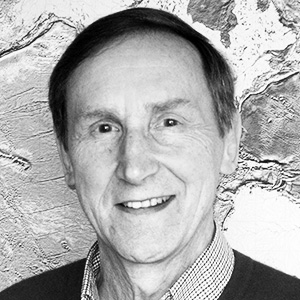Citation

Anthony “Tony” Watts, a distinguished marine geophysicist, made a number of fundamental contributions to the study of the structure and evolution of the world’s ocean basins and their margins. His pioneering work on isostasy and flexure of the oceanic lithosphere led to explaining the origin of island arcs, deep-sea trenches and mountain belts, the deep structure of continental margins, oceanic islands and seamounts, and the relative role of oceanic plate processes compared to mantle dynamics in contributing to Earth’s gravity and topography fields. His lifelong work is very elegantly presented in the book Isostasy and Flexure of the Lithosphere. By comparing the predictions of simple elastic and viscoelastic plate models to gravity, geoid, and bathymetry data in the vicinity of ocean islands and seamounts, he was able to constrain the elastic thickness, a proxy for the long-term strength of the oceanic lithosphere, and showed that the elastic thickness depends on the age of oceanic lithosphere at the time of loading. He extended this method to loading of sediments on the continental margin, allowing us to understand the evolution of sedimentary basins.
In order to further confirm the flexural effect due to large geological loads directly, rather than infer them from gravity and geoid data, Tony led a number of large-scale seismic reflection and refraction experiments in the Atlantic and Pacific Oceans. His Hawaiian Islands seismic experiment showed that the load of the islands has flexed the Pacific oceanic crust downward immediately beneath the load and upward in flanking regions. The seismic data revealed the very first evidence of magmatic underplating beneath an ocean island. He subsequently led seismic experiments over Canary, Cape Verde Islands, and Louisville Ridge that revealed evidence of other phenomena such as viscoelastic stress relaxation in flexural moats, mantle dynamic tilting, and uplift of flexural moats.
Tony does not like the word “retire” and remained very active in acquiring new data and working with students and postdocs. Apart from doing research, Tony has been at the forefront in training the young generation of marine geoscientists and has trained more than 50 Ph.D. students and postdocs, who have become leaders in their field. He has been inspirational for many of us and has played a key role in the marine geophysics community word wide. I would like to thank Tony for providing leadership over past 40 years and invite you to join me in congratulating him for the 2020 AGU Maurice Ewing Medal, a well-deserved honor.
—Satish Singh, Institut de Physique du Globe de Paris, France
Response
Thank you, Satish, the U.S. Navy, and AGU for this award of the Maurice Ewing Medal. It is a great honor for me since I have long admired “Doc” Ewing, his vision, and his passion for ocean exploration. I remember well when, as a young scientist, I first met him a few days after arriving at Lamont.
There are many people who I would like to thank for this award. The late Martin Bott, my Ph.D. thesis adviser, and Bosco Loncarevic and Manik Talwani, who first gave me the opportunity to go to sea and explore the world’s ocean basins and their margins.
Lamont in the early 1970s was a hive of activity running three research ships to all corners of the world oceans. It was not long after arriving I found myself on the Vema, battling Atlantic swells and Lamont’s unique two-wire “core and camera a day” operation in between collecting new geophysical data. The late Walter Pitman and Manik were using magnetic data to reconstruct the opening of the Atlantic, and I was keen to use gravity data to learn more about the rigidity of the plates and test the assumptions that made such reconstructions possible.
Unraveling the story of flexure, its history, and its universality has been a fascinating learning experience, and I would like to add a special thanks to Dick Walcott for his early encouragement; Jim Cochran for his work on sediment and volcano loading; Paul Stoffa, Peter Buhl, Christine Peirce, Donna Shillington, and Robert Dunn for their help in facilitating complex seismic experiments at sea to test the flexure model; the late Evgenii Burov and Shijie Zhong for their insights in linking flexure to crust and mantle rheology; and last, but not least, my extraordinarily talented students, too many to name here, who have gone on and taken the subject to even higher levels.
We live at a time when the ocean continues to play a vital role in Earth system science. But only ~15% of the seafloor has been mapped in detail, and imaging of subseafloor structures is limited. I am excited therefore about the Seabed 2030 project to map the entire seafloor, the International Ocean Discovery Program project to drill to oceanic Moho and sample pristine mantle, the ultradeep seismic projects that are planned to image the entire oceanic lithosphere/asthenosphere system, and the challenges they will pose for the next generation of marine geoscientists.
—Anthony Brian Watts, University of Oxford, Oxford, U.K.
Citation:
(2021), Anthony Brian Watts receives 2020 Maurice Ewing Medal, Eos, 102, https://doi.org/10.1029/2021EO158484. Published on 18 May 2021.
Text © 2021. AGU. CC BY-NC-ND 3.0
Except where otherwise noted, images are subject to copyright. Any reuse without express permission from the copyright owner is prohibited.
